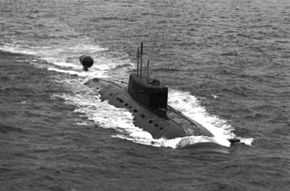Sierra-class submarine
 | |
| Class overview | |
|---|---|
| Builders: | Gorky, later towed to Severodvinsk for completion |
| Operators: |
|
| Preceded by: | Alfa class submarine |
| Succeeded by: | Akula-class submarine |
| Completed: | 4 |
| Active: | 3+1 in overhaul |
| General characteristics | |
| Displacement: | Sierra I: 7,200 tons (surfaced) 8,100 tons (submerged) Sierra II: 7,600 tons (surfaced) 9,100 tons (submerged) |
| Length: | Sierra I: 351 ft (107 m) Sierra II: 364.2 ft (111.0 m) |
| Beam: | Sierra I: 41 ft (12 m) Sierra II: 46.6 ft (14.2 m) |
| Propulsion: | Sierra I & II: 1 × PWR, 190 MW 2 × 1,002 hp emergency motors 1 shaft, 2 spinners |
| Speed: | Sierra I & II: 10 knots (18.5 km/h) (surfaced) Sierra I: 34 knots (63.0 km/h) (submerged) Sierra II: 32 knots (59.3 km/h) (submerged) |
| Range: | Effectively unlimited, except by food supplies |
| Complement: | Sierra I & II: 61 |
| Armament: | Sierra I & II: 4 × 25.6 in (650 mm) torpedo tubes 4 × 21 in (530 mm) torpedo tubes • SS-N-21 Sampson SLCM • SS-N-15 Starfish anti submarine weapon: 200 kt depth charge or 90 kg HE Type 40 torpedo • SS-N-16 Stallion, 200 kt depth charge or 90 kg HE Type 40 torpedo Minelaying configuration: 42 mines instead of torpedoes |
The Sierra I class (NATO reporting name) or (Soviet design serial number) Project 945 (Барракуда/Barrakuda) nuclear submarine was the Soviet Union's successor class to the partly successful Project 705 Lira (Alfa) class submarine. The Sierra class has a light and strong titanium pressure hull which enables the class to dive to greater depths, reduce the level of radiated noise and increase resistance to torpedo attacks. It is powered by a single OK-650 pressurized water reactor. Sierra I and its successor Sierra II classes submarines are designed by Lazurit Central Design Bureau ("Lazurit" is the Russian word for lazurite).
The Sierra II class (NATO reporting name) or Project 945A (Кондор/Kondor) nuclear submarine was a successor to the Sierra I with improved quieting and sonar.[1] The Sierra II was specifically developed for search and destroy missions against US nuclear submarines. It has a smaller turning circle than any other modern submarine, with speeds and diving depth greater than its American counterparts.
Sierra I

The first hull, Karp, was laid down in May 1982 at the Gorky shipyard and was launched in August 1983 before being transferred to Severodvinsk for fitting out. It was laid up in 1987. The next hull to be built was the Kostroma, which was launched in July 1986 and was commissioned in September 1987. K-276 Kostroma was put into a drydock after its February 11, 1992 collision with USS Baton Rouge (SSN-689) in the Barents Sea, off Kildin Island.[2] The submarine was repaired on 29 June 1992 and was renamed Krab, but in 1996 its original name was returned and it is still in service with the Russian Northern fleet. The Sierra I class was also fitted with a releasable escape pod for the crew. The pod is covered by a V shaped casing on the port side of the sail.
Soviet titanium technology was far in advance of the West's, requiring fewer passes to achieve weld at the disadvantage of the cost of each hull which limits numbers built despite the advantages of greater depths and underwater speed. This was clearly shown in the Sierra class.
On March 5, 2013 the Russian news agency Izvestiya reported that the Russian Navy has decided to return Hull 1 Karp and Hull 2 Kostroma to service. The necessary upgrade work is expected to take 3 years and will be carried out at Severodvinsk.[3][4]
Submarines in class: Plan to upgrade the two ships on the CA "Zvezdochka" on the project 945M[5]
- B-239 Carp - commissioned 1987, laid up 1997, being reactivated by 2017
- B-276 Kostroma - commissioned Sep 1987, active
Sierra II

The Sierra II (Project 945.A - Кондор/Kondor) class has a considerably larger sail which is 16.5 ft (5.0 m) longer than the Sierra I type. The sail also has a curious flat, square leading edge. The masts are offset on the starboard side to make way for two escape pods in the sail. The starboard side also has a 10-point environment sensor fitted at right angles to the front end of the sail. Also, the Sierra II type has a much larger pod on its after fin. The pod houses the Skat 3 passive very low frequency towed array.
In October 2012 a Sierra II class submarine deployed to the North Atlantic and carried out a patrol off the US East coast.[6]
Submarines in class: Plan to upgrade the two ships on the CA "Zvezdochka" on the project 945M[7]
- B-534 Nizhniy Novgorod - commissioned Dec 1990, active [8]
- B-336 Pskov - commissioned 1993, active
Sierra III (provisional)

The sole possible Sierra III/Project 945AB (Mars), was laid down in March 1990 but was scrapped in November 1993 before completion.[9]
References
- ↑ Norman Polamr and K. J. Moore, 'Cold War Submarines,'
- ↑ http://web.archive.org/web/20061002201930/http://www.system-safety.org/~issc_2006/Shaw-awards%20dinner%20thursday.pdf
- ↑ Nilsen, Thomas (2013-03-05). "Brushes dust off 25-year old sub". Barentsobserver. Retrieved 2013-03-09.
- ↑ "Russia to Resurrect Titanium Submarines | Defense | RIA Novosti". En.rian.ru. Retrieved 2013-03-09.
- ↑ http://flotprom.ru/news/?ELEMENT_ID=139706
- ↑ "Report: Russian Nuclear Attack Submarine Detected Near US". Newsmax.com. 2012-11-05. Retrieved 2013-03-09.
- ↑ http://flotprom.ru/news/?ELEMENT_ID=139706
- ↑ "п²п╦п╤п╫п╦п╧ п²п╬п╡пЁп╬я─п╬п╢ (п©п╬п╢п╡п╬п╢п╫п╟я▐ п╩п╬п╢п╨п╟)". Dic.academic.ru. 2003-07-29. Retrieved 2011-12-28.
- ↑ Подводные Лодки, Том 1, Часть 2, Ю.В. Апалков, Санкт Петербург, 2003
- Robert Hutchinson, Submarines, War Beneath The Waves, From 1776 To The Present Day
- - Article from FAS
- Article (Belarusian)
| Wikimedia Commons has media related to Sierra class submarines. |
| ||||||||||||||||||
| ||||||||||||||||||||||||||||||||||